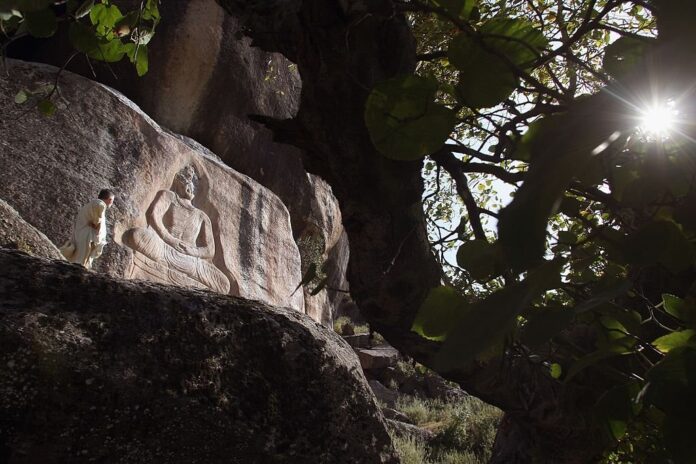PESHAWAR: Archeologists have found Buddha artifacts in northwest Pakistan dating back to 1,800 years, an official said.
The rare artifacts have been found in the Swabi district, located some 83 kilometres from Peshawar, Abdul Samad, the director of the Khyber Pakhtunkhwa Archeology Department, told Anadolu Agency.
“We have found around 400 new antiquities belonging to Gandhara Civilisation during an ongoing excavation at Baho Dheri village of Swabi over the past six months,” he said.
The discoveries include a 73-meter high stupa, the largest of its kind so far found in the region, and a rare 10-feet life-size statue of Gautam Buddha, the founder of Buddhism.
The stupa, which is 73-meter high, is the largest of its kind found in this region so far.
“This statue is not in intact form. We need to work to restore in its original shape,” Samad said.
Other antiquities include seated Buddha statues, the original floor of the largest stupa dated back to 1,800 years, and a statue in meditation pose, he added.
“These antiquities are not mere art pieces but they were used for worship purposes,” he further said, adding the Buddhist disciples used to take rounds of the stupa in the anti-clockwise direction.
Mostly, he said, round, Indian, and Ashokan-style stupas have been found in the region, some of them dating back to 2,200 years, in addition to square stupas, which were introduced by the ancient Khyber Pakhtunkhwa.
The latest discoveries are the outcome of an ongoing excavation in the region over the past six months.
“We have so far done (completed) 40 percent of the planned excavation. 60 percent (excavation) is still left,” said Fawad Khan, head of a 20-member team of archaeologists involved in the excavation.
Speaking to Anadolu Agency, he said that more “interesting” discoveries are expected.
Important region for Buddhism
Khan said that the fresh discoveries have added a “new chapter” to the history of the Gandhara Civilisation.
Emerged in 500 B.C., the ancient Gandhara Civilisation sprawled the region, which included Peshawar, Mardan, Swabi, Swat, Buner, and Bajaur situated in the northwest, and Texila in the northeast of today’s Pakistan, in addition to Kabul and northern Afghanistan.
Khyber Pakhtunkhwa is home to 70 percent of the sites in the country sacred to Buddhists.
Once known as the heart of the Gandhara civilisation, Takhtbai or Takht-i-Bhai (throne of origins) — a small scenic town located some 112 km (69 miles) from Peshawar — is the most visited site by the Buddhists, who flock to see the ancient monastery dated back to the 1st century, according to Samad.
In the entire Khyber Pakhtunkhwa, which borders neighbouring Afghanistan, there are some 20,000 archaeological sites, of them, 2,000 belong to Buddhist Civilisation.
“The region comprising Swabi and Mardan is so important for Buddhists in general and for the Korean peninsula in particular as Buddhism was introduced to that region (Korea) by a monk from Swabi some 1,600 years ago,” Khan said.
Discoveries to boost religious tourism
Thousands of tourists from Japan, China, Sri Lanka, South Korea, Hong Kong, and Myanmar visit the Buddhist sites in Pakistan every year, following improved law and order in recent years.
The army has launched a series of onslaughts on militants, particularly in the tribal region along the Afghan border since 2014, clearing 95 percent area of terrorists.
According to the interior ministry figures, there has been an 80 percent decline in the number of terrorist attacks in the country since 2014.
The fresh discoveries, archaeologists, and tourism authorities believe will give a further boost to already picking up religious tourism in Pakistan.
Pakistan is just 70 years old, but it is situated in a region that has been home to the world’s three major religions — Hinduism, Buddhism, and Sikhism — for centuries.
The Muslim nuclear state hosts scores of revered pilgrimage sites — dating back to 5,000 years — for not only the followers of the three religions but also from some pre-historic religions such as Aryan, Vedic, Barhaman, and ancient Iranian and Greek religions.
Badly hit by the events related to the 9/11 attacks on Washington and New York, Pakistan’s religious tourism is now picking up mainly because of the improved law and order, and the government’s realisation of the economic and political potential of this sector.
“These latest discoveries, which include rare stupas and other artifacts will certainly boost the religious tourism in Pakistan, which is already picking up,” Samad observed.
Echoing his views, Khan, the chief archaeologist, said the discoveries would attract the Buddhist community from across the world.
Located some 27 km (17 mi) from Islamabad, Taxila — also known as Tukshla in olden times — is another holy site, which includes a Mesolithic cave and the archaeological remains of several Buddhist monasteries.
Apart from Khyber Pakhtunkhwa, Punjab is home to the five most important pilgrimage sites for Sikhs.
They include the birthplace of Baba Guru Nanak, the founder of the Sikh religion who was born in 1469 in Nankana Saheb district, and Gurdwara (monastery) Punja Sahib in Hasan Abdal town, where the handprint of Guru Nanak is believed to be imprinted on a boulder at the monastery.
The two sites are visited by thousands of Sikhs from India, Europe, and America every year.
Katas Raj temple in Chakwal district and Sadhu Bela temple in Sukkur are the two most visited religious sites by Hindus from across the world.
Hindus — Pakistan’s largest minority — equally revere the water of a lake in the Katas Raj temple as they believe the lake was filled with the tears of Shiva, one of the principal deities of Hinduism.
Hindus make up 4 percent of the total 210 million population.























